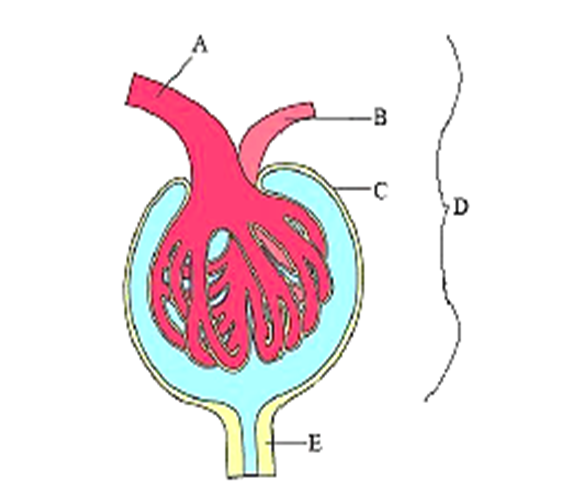 Multiple Choice Questions
Multiple Choice QuestionsIdentify the correct statement regarding urine formation
Counter current mechanism works around the glomerulus and PCT
To prevent diuresis, ADH facilitates water reabsorption
from the latter parts of the tubule
Maximum absorption of electrolytes occurs in the Henle's loop
A decrease in blood pressure can increase the glomerular filtration rate
A decrease in blood pressure can increase the glomerular filtration rate
Choose the wrong statement regarding urine formation
Filtration is non-selective process performed by glomerulus
The glomerular capillary blood pressure causes filtration of blood through three layers
GFR in a healthy individual is approximately 125 ml/min
A fall in GFR activates the JG cells to release renin
A fall in GFR activates the JG cells to release renin
Vasa recta refers to
rectum region of the insects
blood capillaries in invertebrates
a fine blood capillary network of afferent arteriole
a fine capillary which runs parallel to Henle's loop
a fine capillary which runs parallel to Henle's loop
Find the wrongly matched pair.
Balanoglossus - Proboscis gland
Earthworm - Nephridia
Grasshopper - Malpighian tubules
Prawn - Flame cells
Prawn - Flame cells
The condition in which the kidneys fail to conserve water leading to water loss and dehydration due to impaired ADH synthesis or release is
Grave's disease
Addison's disease
Diabetes insipidus
Cretinism
Cretinism
In mammals, ammonia produced by metabolism is converted into urea in the
Kidney
Liver
Spleen
Blood
Blood
Read the following statements and choose the correct option
(i) The glomerular filtration rate in a healthy individual is about 180 ml per day.
(ii) All the constituents of the plasma pass into the lumen of Bowman's capsule.
(iii) 70/80% of electrolytes and water are reabsorbed in the PCT.
(iv) Angiostesin II increases the glomerular blood pressure and GFR.
(v) The counter current systems contribute in concentrating the filtrate.
(i) and (ii) only are correct
(v) alone is correct
(ii), (iii) and (iv) only are correct
(iii), (iv) and (v) only are correct
(iii), (iv) and (v) only are correct
The parts labeled as (A), (B), (C), (D) and (E) of renal corpuscle represents

A - Afferent arteriole; B - Efferent arteriole; C - Glomerulus; D - Bowman's capsule; E - Proximal convoluted tubule
A - Efferent arteriole; B - Afferent arteriole; C - Glomerulus; D - Bowman's capsule; E - Proximal convoluted tubule
A - Proximal convoluted tubule ; B - Efferent arteriole; C - Glomerulus; D - Bowman's capsule; E - Distal convoluted tubule
A - Afferent arteriole; B - Efferent arteriole; C - Bowman's capsule; D - Glomerulus; E - Proximal convoluted tubule
A - Afferent arteriole; B - Efferent arteriole; C - Bowman's capsule; D - Glomerulus; E - Proximal convoluted tubule
Which of the following factors is responsible for the formation of concentrated urine?
maintaining hyperosmolarity towards inner medullary interstitium in the kidneys.
Secretion of erythropoietin by Juxtaglomeular complex.
Hydrostatic pressure during glomerular filtration
low levels of antidiuretic hormone
A.
maintaining hyperosmolarity towards inner medullary interstitium in the kidneys.
The proximity between loop of henle and vasa recta as well as counter current in them help in maintaining as increasing osmolarity towards the inner medullary interstitium. This mechanism help to maintain a concentration gradient in medullary interstitium so human urine is nearly four times concentrated than initial filtrate formed.
